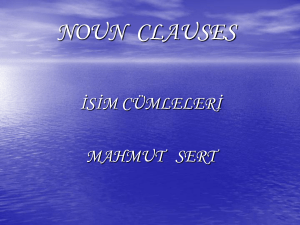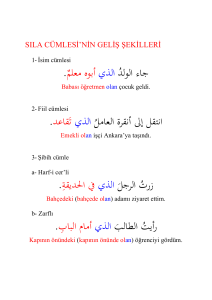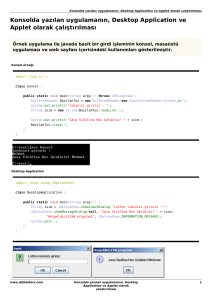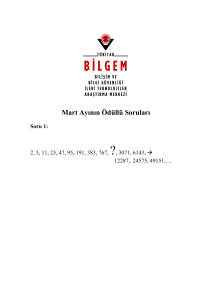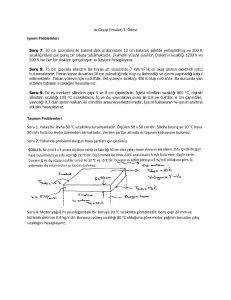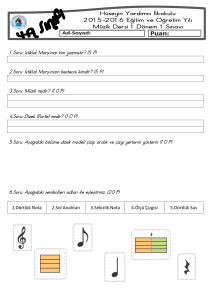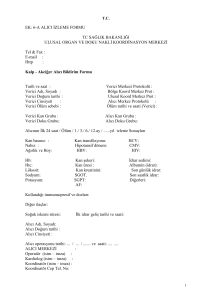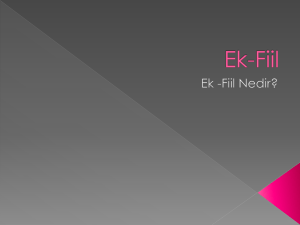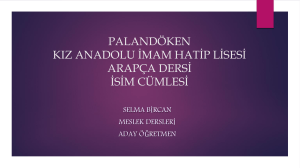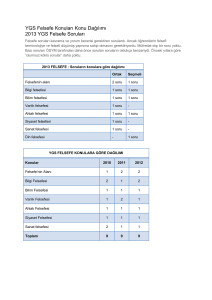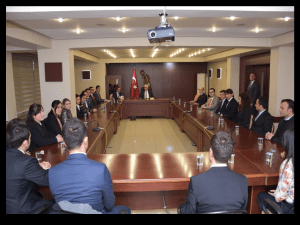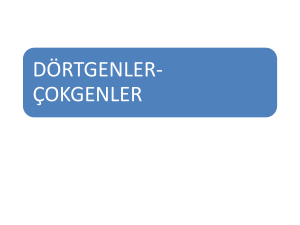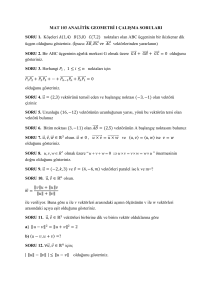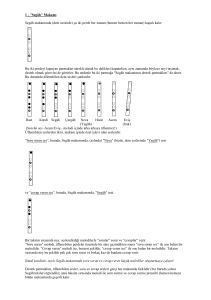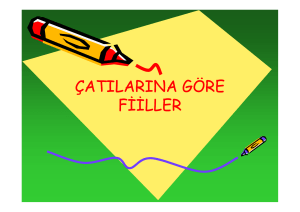noun clauses - files.eba.gov.tr
advertisement
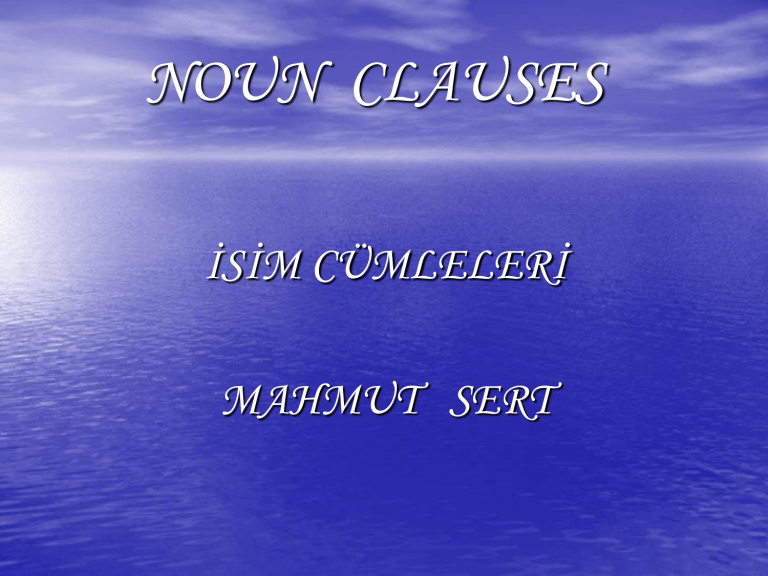
NOUN CLAUSES İSİM CÜMLELERİ MAHMUT SERT İSİM CÜMLELERİ • İsim cümlesi nedir? • Soru kelimesiyle başlayan isim cümleleri • ‘Whether or not’ ‘If …or not’ ile başlayan isim cümleleri • ‘That’ ile başlayan isim cümleleri İsim Cümlesi Nedir? İsim cümlesi bir cümlede isim gibi işlev gören cümleciktir.Yani cümlede özne ya da nesne görevinde bulunabilir. Örnek: I don’t know the answer.(nesne) isim(noun) I don’t know what the answer is.(nesne) isim cümlesi(noun clause) İSİM CÜMLESİ (NOUN CLAUSE) SORU CÜMLESİYLE BAŞLAYAN İSİM CÜMLESİ ‘WHETHER OR NOT’ ‘IF …OR NOT’ İLE BAŞLAYAN İSİM CÜMLESİ BAZI SIFATLARDAN SONRA ‘THAT’İLE BAŞLAYAN İSİM CÜMLESİ BAZI İSİMLERDEN SONRA BAZI FİİLLERDEN SONRA ‘THE FACT THAT’İLE KULLANABİLİRİZ Soru Kelimesiyle Başlayan İsim Cümleleri Soru sözcüğüyle başlayan bir soruyu, isim cümlesi haline dönüştürmek için öncelikle o cümleyi soru olmaktan kurtarmamız gerekir. Bunun için de soru cümlesi düzenini düz cümle düzenine dönüştürmeliyiz. Bilindiği gibi İngilizce soru cümlesi yardımcı fiil+özne+yüklem formülü ile oluşturulur. Düz cümle ise özne+yardımcı fiil+yüklem düzeniyle kurulur. Örnek: Soru: Why is he coming tomorrow? İsim cümlesi: Why he is coming tomorrow is a secret. (noun clause) Eğer bir soru sözcüğü cümlenin öznesini soruyorsa, o soru cümlesinde özne olarak bir başka sözcük bulunmadığı için, cümleyi düz cümle biçimine dönüştüremeyiz.Bu nedenle, soru cümlesi ile isim cümlesinin(noun clause)sözcük dizimi aynı olur. Örnek: Soru:Who is coming tomorrow? İsim cümlesi:I don’t know who is coming tomorrow. Geniş zaman(simple present tense) ve geçmiş zamanla(simple past tense) özneyi sorarken ‘ do, does ‘ ya da ‘ did ‘ yardımcı fiilleri kullanılmaz. Örnek: Soru:What happens here at the weekend? İsim cümlesi:Please tell me what happens here at the weekend. Soru:What happened here yesterday? İsim cümlesi:Please tell me what happened here yesterday. Eğer aynı soru sözcüklerini kullanarak cümleni nesnesini soruyorsak, ‘ do, does ‘ ya da ‘did ‘ yardımcı fiilleri kullanılır. Örnek:Who visits him eveyday?(“ Who” özneyi soruyor) ( Onu her gün kim ziyaret ediyor?) I don’t know who visits him everyday. (Onu her gün kimin ziyaret ettiğini bilmiyorum.) ‘ Who, what, whose’ gibi soru sözcükleriyle sorabileceğimiz şu soru tiplerine de dikkat ediniz: Who are those girls? fiil özne I don’t know who those girls are. özne fiil What is this substance? fiil özne Do you know what this substance is? özne fiil Whose is that car? fiil özne Do you know whose that car is? özne fiil ** Soru sözcüğüyle başlayan bir isim cümlesi oluşturabilmek için, bu sıraladığımız kuralları dikkate alarak, örneklerde kullandığımız soru sözcüklerinin yanı sıra diğer bütün soru sözcüklerini de kullanabiliriz: which,how,how many,how much,how often,how long etc. “Whether or not” veya “If… or not” ile Başlayan İsim Cümlesi Yardımcı fiille başlayan bir soruyu isim cümlesine dönüştürürken, isim cümlesinin başına “whether” ya da “if” getirilir ve soru cümlesi, düz cümle biçimine çevrilir. ”Or not” whether’dan hemen sonra gelebilir (whether or not) ya da isim cümlesinin sonunda yer alabilir (whether…or not). Ancak “or not” “if”den hemen sonra kullanılmaz. Sadece isim cümlesinin sonunda yer alabilir (if…or not). Her iki cümlede de “or not” kullanmayabiliriz ve bu durumda anlam değişmez. Örnek: Is she coming to the party? I wonder whether she is coming to the party(or not). whether or not she is coming to the party. if she is coming to the party(or not). (Onun partiye gelip gelmeyeceğini merak ediyorum.) Eğer “isim cümlesi” özne durumundaysa sadece “whether” kullanılr. “If” bu şekilde cümle başında kullanılmaz. Örnek: Whether she is coming to the party or not isn’t certain yet. Whether (or not) she is coming to the party isn’t certain yet. (Onun partiye gelip gelmeyeceği henüz belli değil.) -Do we have to return our assignments by Monday? -I don’t know whether we have to return our assignments by Monday. -May I leave early today? -I’d like to learn if I may leave early today. “That” İle Başlayan İsim Cümleleri Düz cümleleri isim cümlesi biçiminde kullanırken, isim cümlesinin başına “that” getirilir. Eğer isim cümlesi cümlede nesne durumundaysa, “that” kullanmayabiliriz. Örnek: She doesn’t like pop music. İsim cümlesi: We know (that) she doesn’t like pop music. (Onun pop müziğini sevmediğini biliyoruz.) Eğer isim cümlesi cümlede özne durumundaysa, isim cümlesinin başındaysa “that” kaldırılamaz. Örnek: He committed the crime. İsim cümlesi: That he committed the crime is obvious. (Suçu onun işlediği açık.) Ancak “isim cümlesi” nin bu şekilde cümlenin başında özne olarak kullanılması pek yaygın değildir. Onun yerine, cümleye “it” ile başlayıp isim cümlesini ortada kullanmak daha yaygındır. Örnek: It is obvious (that) he committed the crime. (Suçu onun işlediği açık.) • “İsim cümlesi” ni yaygın olarak: a)Bazı sıfatlardan sonra b)Bazı isimlerden sonra c)Bazı fiillerden sonra d)”The fact” ile kullanabiliriz. a)Belli Sıfatlardan Sonra “İsim Cümleleri”: Sorry, glad, happy, afraid, surprised, disappointed, pleased, sure, etc. gibi duygu ya da tavır bildiren sıfatlardan sonra “isim cümlesi” kullanabiliriz. Örnek: You passed the exam. İsim cümlesi: I am glad (that) you passed the exam. Sonu –ing ve –ed ile biten bazı sıfatlardan sonra “isim cümlesi” kullanımı oldukça yaygındır. Surprised, amazed, pleased gibi sonu –ed ile bitenler, ancak bir canlının duygularını ifade edebileceği için “I, you, we, they, Peter, my mother” gibi öznelerle kullanılırlar. Surprising, amazing, pleasing gibi sonu –ing ile bitenler ise olayların durumunu ifade ettikleri için özne olarak “it” gerektirirler. Örnek: It’s very surprising that she was dismissed from her job. (İşinden atılması çok şaşırtıcı.) I’m very surprised that she was dismissed from her job. True, strange, fair, unfair, unfortunate, obvious, apparent, too bad, likely, unlikely gibi sıfatlarla da “isim cümlesi” yaygın olarak kullanılır. Örnek: It’s likely (that) there will be another rise in prices soon. b) Belli isimlerden sonra “isim cümleleri”: Miracle, pity, shame, wonder, relief, a good thing, fact, belief, theory, impression gibi isimlerden sonra “isim cümlesi” kullanabiliriz. Örnek: It’s a wonder (that) she survived the accident. c)Belli fiillerden sonra “isim cümleleri”: Bazı fiiller, kendilerinden sonra isim cümlesi alabilirler. Bu cümlelerde isim cümlesi, yüklemin nesnesi durumundadır. Örnek: I will prove his innocence I will prove that he is innocent (Onun masum olduğunu ispatlayacağım.) Yaygın olarak “isim Acknowlegde Beg Claim Decide Expect Feel Forget Hope Imagine cümlesi” alan fiiller şunlardır: Know Learn Notice Object Point out Predict Realise Recommend Remember Reply Say See Show State Teach Tell Understand Wish The teacher claims that he cheated during the exam. He never admits that he has made a mistake. I assume that the meeting will have to be cancelled. The result of the exam shows that you didn’t study hard enough. Appear, seem, happen, occur ve turn out fiilleri özne olarak “it” kullanmayı gerektirir. Örnek: It appears that we will face terrible conditions on this expedition It occurs to me that his action was deliberate. “Yapacağımız” bir şey için söz vermek anlamına gelen “promise” ve “bir şeyin” olacağını önceden tahmin etmek” anlamına gelen “predict” fiilleri, isim cümlesi nde future tense kullanmayı gerektirir. Örnek: She promises that she will be more careful next time. The villagers predicted that the harvest would be good this season. Beg,command, decide, demand, determine, order, resolve, urge, insist ve suggest fiilleriyle isim cümlesinde daha çok “should” kullanılır.Temel cümlenin yüklemi past tense olduğunda da isim cümlesindeki “should” aynı kalır. Örnek:I suggest that you should go to a doctor. He demanded that he should be on time for work. d) “The fact” ile isim cümleleri: Bir “isim cümlesi” çoğu zaman “the fact that” ile kullanılabilir. “The fact that” li cümle, özne ya da nesne durumunda olabilir. Örnek: She couldn’t pass the exam. That disappointed us. İsim cümlesi: The fact that she couldn’t pass the exam disappointed us. (Onun sınavı geçememesi bizi hayal kırıklığına uğrattı.) Eğer “that” li cümle, bir preposition’ın nesnesi durumunda ise bu isim cümlesi yalnızca “that” ile başlatılamaz. Bu durumdaki bir “isim cümlesi” “the fact that” kullanmayı gerektirir. Örnek: We are not worried about the fact that she comes home late from work. .
